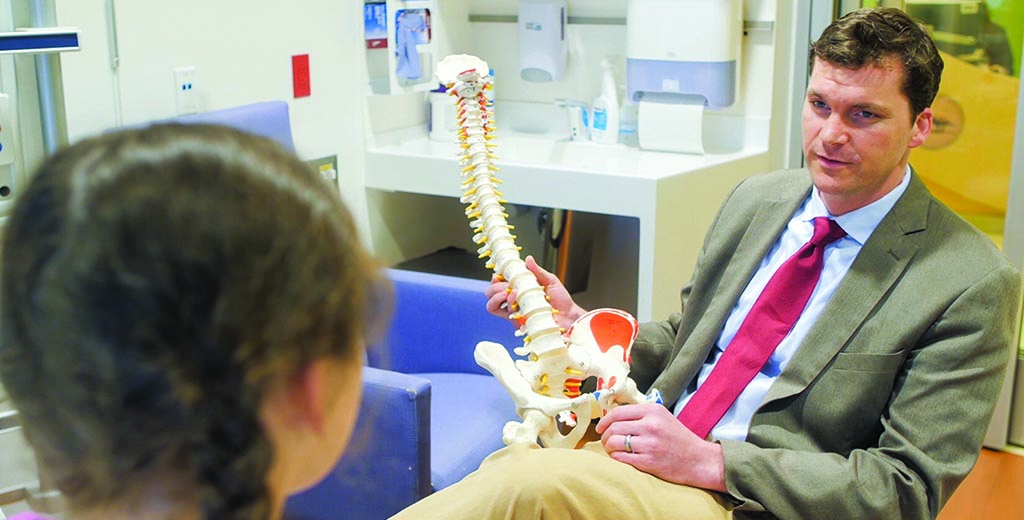Scoliosis is a common condition in which the spine twists and curves sideways instead of running straight down the center of the back.
More than 1 in every 100 adolescents is diagnosed with scoliosis, but it can also occur in younger children. A large spinal curve can cause deformities, pain and muscle spasms, and can even hinder breathing by limiting space for the rib cage and lungs to expand.
Stanford pediatric orthopedic surgeon John Vorhies, MD, who sees scoliosis patients through the Spine Program at Lucile Packard Children's Hospital Stanford, is conducting several research projects to improve treatments for these kids and teens.
I talked to him recently about what drew him to the field and what research he's excited about now. This Q&A has been edited and condensed for clarity.
Why did you decide to become a pediatric orthopedic surgeon?
I initially thought I would be an internal medicine or infectious disease doctor, but I realized that the day-to-day work in those specialties is less hands-on than I wanted. I'm interested in art and sculpture; I did ceramics for many years and enjoy using my hands.
In pediatric orthopedic surgery, you have the technical elements of any surgical specialty, but there is also this element of growth. In anything you do, you have to think about how much a child is going to grow, and how that's going to affect their healing and your work. It's exciting because patients have so many years to benefit from what we do.
And I enjoy working with kids. In medical school you spend time in a lot of different clinics, and I was always happier in pediatrics. Kids are funny! I could joke with them and they'd laugh.
Why have you chosen to specialize in scoliosis?
Treating scoliosis gives me the opportunity to care for a broad range of patients, from healthy adolescents who are high-performing athletes and have nothing else medically wrong, to infants and small kids under age 5.
It's a tougher disease when it starts early, when they have so many years ahead, but that means the interventions we offer are much more meaningful.
I also see patients with other medical needs, such as cerebral palsy or muscular dystrophy. These children may already have lung problems when they develop scoliosis, putting them at risk for further breathing problems. Worsening scoliosis can lead to frequent hospitalizations or a need for ventilation. But by operating, I can halt its progression, and that can improve many parts of patients' lives and can even extend their lives.
Within orthopedic surgery, scoliosis cases represent the highest-risk, longest operations we perform, so it's a high-impact area for research to make our interventions safer and more effective.
Around 5-10% of kids and teens with scoliosis need treatment that often includes wearing a brace on the torso that pushes on their ribs and spine as they grow. How is your research addressing bracing?
Wearing a hard plastic brace for 12-18 hours a day is tough. You have to wear it to sleep and at school, but can take it off for sports and some other activities. The success of the treatment directly correlates to how long it's worn.
We're studying how to encourage people to wear their brace as prescribed. One study, with my colleague Kali Tileston, MD, asks which patients are at risk for not wearing their brace, based on the psychological concept of growth mindset. We survey patients to gauge their concept of their own health: Is it something that they think they can change? That's been shown to affect adherence to treatment and offers an opportunity for us to intervene.
We also use body-heat sensors that track how long a patient wears their brace. Patients are generally very excited about getting real data on how they're doing -- it gives them self-motivation. For adolescents, it's very hard to do something so taxing for a long-term goal, so we're thinking about how to link brace data to short-term rewards for them.
With Stanford biomedical engineers and my fellow surgeon Carla Pugh, MD, we are also designing sensors that go inside the brace to measure how much pressure it puts on different parts of body. Is it pressing hard enough to give results, but not so hard that it's uncomfortable? That project is in pre-clinical testing. Both this project and our mindset research have funding from the Scoliosis Research Society.
You also have a project that creates 3D maps of patients' torsos. What are the benefits of that approach?
X-rays used to monitor scoliosis measure only the sideways curve in the spine. We're developing quantitative ways to measure body shape in 3D: A smartphone or tablet with a special sensor completes the scan in under a minute and creates a 3D reconstruction to correlate with X-ray findings. My colleague Michael Gardner, MD, has used this technology to describe how body shape changes when someone has a fracture, and now we're applying it to scoliosis. This approach may help track bracing outcomes; help us monitor kids with mild scoliosis to determine whether they need treatment; and reduce radiation exposure for our patients.
About 1 in every 100 scoliosis patients need spinal fusion. How is your team working to improve this surgery?
A patient's No. 1 concern about scoliosis surgery is pain afterward. We have made great advances to reduce that. For the past year, we've been working with our anesthesiologists to put pain catheters around spine that deliver anesthesia to the site of the surgery over the next two days.
Anecdotally, this seems to reduce pain with fewer side effects. Anesthesiologist Chi-Ho Ban Tsui, MD, and I have received a grant to conduct a prospective randomized controlled trial testing whether this technique helps patients recover with recover with fewer opioids and get back to normal activities more quickly.
Image of Stanford pediatric orthopedic surgeon John Vorhies, MD, with a Lucile Packard Children's Hospital Stanford Spine Program patient.




